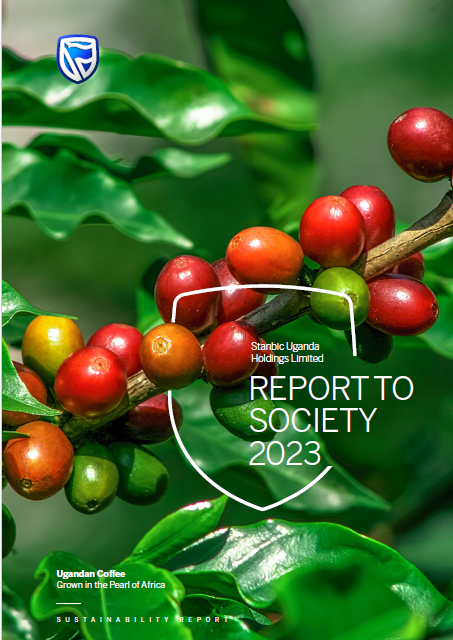Stanbic Uganda Holdings Limited (SUHL) is one of Uganda’s sustainability frontline leaders in the industry/corporate business space. As such, for the last two years, Stanbic has always produced a Sustainability report in addition to its annual financial reports. Thus, Stanbic is leading the way in speaking the new language of business.
The ‘Report to Society 2023’ was compiled basing on the Global Reporting Initiative (GRI) standards and guidelines. In addition to this, Stanbic employed their internal SEE (Social, Economic and Environment) framework fused with the ESG (Environmental, Social and Governance) management matrix. With this, Stanbic aims at maximizing positive impact and effective governance and risk management.
The Wins:
In its second year of sustainability reporting and disclosures, Stanbic shared its wider goal to play a major role in Uganda’s development. With this, the aim is to drive financial inclusion, enable business growth, create employment, fund the development of critical public infrastructure, facilitate trade, improve education and health outcomes and address energy poverty.
Overall, Stanbic declares several impact wins. On the social impact front, this included UGX 43.5billion in loans that were extended to education institutions; and the 200,000 mothers supported through the Stanbic maternal health programmes. On the Economic impact front, the Stanbic Business Incubator was key with over 3248 Small and Medium Enterprises trained through this. On the Environmental Front, Stanbic has been key on partnerships with campaigns such as the ROOTS campaign to drive tree planting, plastic recycling initiatives with Cocacola and an introduction of the ESG screening into the loan assessment process.
Stanbic is also big on its people, with 30% of the wealth created by the Bank going back to the employees, and a deliberate move to drive employee growth and retention.
The Missing Link in Stanbic’s Sustainability
Despite the gains on the Sustainability front by Stanbic, there are more questions that remain unanswered. Although Stanbic has demonstrated it is doing something, but is it doing enough? Is it reporting all that needs to be reported?
Question One: What were the targets?
Although Stanbic has outlined the different scores such as 74,000 trees that were planted, 1,244 kilograms of plastics that were recycled from its premises. What were the targets? What were the goals? In this way, it becomes easy to assess Stanbic’s achievements against the set targets? What was the KPI for electricity consumption, for water consumption, for fuel consumption? How many MSMEs were meant to be trained?
Question Two: Will the ESG Screening Cater for Already Issued Loans?
Considering that the ESG screening is a novel addition, will this apply retrospectively? What is the ESG risk of some of the loans that were already dispensed? Is there any risk that Stanbic needs to outline. At Ortega Group, we think this retrospective approach has materiality. As such, the entire existing loan portfolio should be re-assessed against this ESG matrix.
Question Three: Limited Disclosure on Operational Impacts
We believe Stanbic has not maintained full disclosure on their operational impacts. Sustainability disclosures should be as micro as possible. Sustainability disclosure is about detail. Take an example of a Stanbic Bank branch, what’s the full carbon footprint on a physical branch? From the Air-conditioning being used, does it pass the green criteria? What about the Stanbic vehicles? Is there a deliberate plan to move from fossil-fuel operated vehicles?
We believe there was limited reporting on the Cybersecurity risks as these by themselves are a risk to ESG, and a more legitimate risk for the banking sector. What is Stanbic doing different? There are also questions on the Cloud Computing impact. This is not mentioned by Stanbic throughout the report. Yet, today, Cloud Computing is now among the biggest threats to sustainability. With Stanbic dependent on the cloud, what is the state of its data centres? Are they running on renewable energies? Are they employing novel cooling solutions?
Question Four: Clarity on the Different Scopes of Emissions
We believe in the next Sustainability report, Stanbic should provide clarity on all its Scope 1, Scope 2 and Scope 3 emissions. The current state of those emissions and efforts around mitigation and a progressive transition plan.
Again, it’s also important to have the sustainability efforts directed towards a measurable end. Tree planting has become the go-to for every organization that seeks to appear to be doing something about sustainability. This could create a green-hushing risk. We believe the impact of the 70,000 trees should be measured. What does that mean in carbon reduction? And what are the maturity levels of these trees? How is the state of these trees monitored? Out of all the planted trees, how many have survived?
Question Five: Embedding Sustainability in Loan Portfolio
Although Stanbic has gone ahead to have Sustainable Procurement with ESG requirements forming a component of supplier contracts, there’s a missing link. And again, Stanbic should also be credited for being deliberate on local sourcing with 88% of spend going to local suppliers. We believe the question of MSMEs is still insufficiently addressed.
Is there an innovative mechanism to enable access to funds for MSMEs? Will Stanbic be deliberate and intentional about lower interest rates for MSMEs? Or will it structure better loan repayment terms for MSMEs? Since sustainability is about organizations putting their money where their values are, we seek a more measurable and demonstrable approach to MSMEs transformation by Stanbic.
We also ask, will businesses that demonstrate better compliance to ESG requirements receive better loan incentives from Stanbic? And can Stanbic become a shaper of Sustainability in Uganda through its lending practices?
Question Six: Sustainability and Sustainable Finance in Uganda
Banks in general must see themselves as critical shapers of sustainability in their environments where they play. Whereas businesses seek to find ESG factors that are material to their operations, Banks on the other hand play the intermediating role as financial resource mobilizers. As such, banks play a critical role of not only driving sustainability within their own operations, but also driving sustainable finance in the economy.
Thus, Banks must be able to demonstrate the presence, availability and accessibility of sustainable finance products within their portfolio. Again, how is Stanbic also aligning its financial intermediation by sector as per Uganda’s Nationally Determined Contribution (NDC) adaptation sectors. Take an example of Agriculture, although it’s a key adaptation sector in the NDCs, it still accounts for only UGX 446 billion of Stanbic’s loan portfolio.
Going Forward
At Ortega Group, we recognize that the journey of sustainability in Uganda is in its early days. However, we also believe in the principle of ‘right first time’ as a foundational baseline for progress. We also recognize the limitations in regulatory frameworks when it comes to sustainability reporting.
The Capital Markets Authority and the Uganda Securities Exchange have not formally pronounced themselves on the non-financial reporting. Should these disclosures be mandatory? Should companies simply take the ‘Comply or Explain’ approach?
Overall, we believe all reporting should be based on the tripartite principles:
First, businesses must demonstrate that they are conducted in an ethical manner (Corporate Governance), secondly, they must show how they manage their key impacts (Economic, Environmental and Social) and finally businesses must show how their products create value for society (contribution to sustainable national development).
We also recognize the need for codification of reporting standards. Will businesses produce multiple reports to take care of the different standards? If one bank reports using GRI while another chooses to report using the Sustainability Accounting Standards Board, are these reports comparable?
Finally, we pronounce that banks being financial intermediaries carry a far greater responsibility in driving sustainability through sustainable financing. We also believe that only detailed sustainability reporting frameworks can enable the tracking of these efforts. Above all, sustainability should henceforth be seen as not just operational but strategic.
Through sustainable lending, banks can be driers of sustainability through their lending (the case of ESG screening). Banks are also resource allocators to this sustainability journey. We also advocate for micro-sustainability, a detail-oriented approach to reporting, and warn against sustainability for sustainability’s sake. By reframing sustainability and viewing it as something strategic to the delivery of the triple bottom line, organizations can avoid the pits of greenwashing and green hushing.

